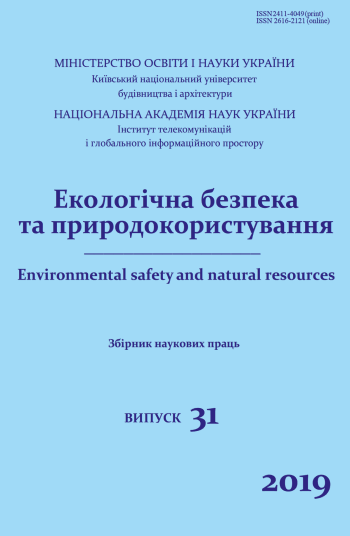Assessment of additional seismic risk of destruction of structures on flooded loesses and loessy-loamy rocks in Ukraine
DOI:
https://doi.org/10.32347/2411-4049.2019.3.11-22Keywords:
seismic risk, loesses, subsidence, engineering and geological conditionsAbstract
Over the recent decades in Ukraine regional activation of flooding of lands, accompanied by landslide formation and subsidence of surfaces take place. In the years 1982-2004, in the southern regions of Ukraine, the areas of underflooding increased 9 times. Therefore the risk of destruction of structures from probable seismic shaking increases in large areas, which will provoke landslides and thixotropic dilution of flooded loesses. The article is devoted to the regional economic assessment of additional seismic risk of destruction of structures in Ukraine in areas of distribution of flooded loesses-rock formations. Obtained data on the modern activation of changes in the geological conditions of loesses and loessy-loamy rocks and increasing their contribution to the increase of ecological and geological risks of life lead to the important conclusion that loess-rock massifs in most regions of Ukraine become vulnerable elements of the geological environment to the impact of increasing technogenic load and global climate change. To strengthening the hazardous properties of loesses and loessy-loamy rocks, in addition to subsidence, reduction of strength, etc., new processes have been added – activation of swelling and thixotropy. They are most active in cities and towns, which is caused by large losses of water and heat from urban networks, which reach 35-45% and exceed the filtration capacity of loesses and loessy-loamy soils. In most cases, this leads to the formation of anthropogenic aquifers as a key factor in the mechanism of degradation loesses and loessy-loamy rocks in cities and the formation of hydro-geodeformation fields during seismic shocks. The consideration of climate parameters significantly changes the value of economic assessment of the additional risk of seismic destruction of structures on flooded loesses and loessy-loamy rocks in Ukraine towards its reduction at the locally objective level. It is also advisable to add the number of days with rain for the year and the number of days with non-freezing soil in winter (November-February) to the climate parameters we consider at this stage. The rapid changes of the engineering-geological state of subsidence rock masses in the conditions of influence of factors of global climate change, the increase of global seismicity and technogenesis, in our opinion, require the development of new regulatory and methodological provisions for the study of loesses and loessy-loamy rocks formations in technogenic loaded and vulnerable regions of Ukraine.References
Rogozin, O. G., & Yakovlev, Y. O. (2015). Potential increase of seismicity in Ukraine as a factor of growth of personal and social safety risk from accidents on chemically dangerous objects. Environmental Safety and Natural Resources , 17(1), 15–27. (in Ukrainian).
Yakovlev, Y., & Rogozin, O. (2018). The factors and possible consequences of regional changes in engineering and geotechnical status of loesses and loessy-loamy soils of Ukraine. Environmental Safety And Natural Resources, 27(3), 5-23. doi:http://dx.doi.org/10.32347/2411-4049.2018.3.5-23. (in Ukrainian).
Fifth national message from Ukraine on climate change. (2009). Ministry of Environment of Ukraine. Kyiv, Ukraine (281 p.). (in Ukrainian).
Yakovlev, Y. O., Rohozhyn, O. H., & Vasyniuk, A. V. (2018). GIS-otsinka zahroz pohirshennia inzhenerno-heotekhnichnoho stanu lesiv ta lesovo-suhlynystykh porid Ukrainy v umovakh hlobalnykh zmin klimatu. In XVII Mizhnarodna naukovo-praktychna konferentsiia «Informatsiini tekhnolohii upravlinnia ekolohichnoiu bezpekoiu, pryrodokorystuvanniam, zakhodamy v nadzvychainykh sytuatsiiakh». (Kyiv, 25-26 veresnia 2018 r.) (pp. 154–156). Kyiv: «Vyd. «Iuston». (in Ukrainian).
DBN В.1.1.-12: 2006. Addition В. – 82 p. (in Ukrainian).
Susidko, M. M., & Luk’ianets, O. I. (2004). Zoning of the territory of Ukraine by the degree of hydrological danger. Naukovi Pratsi UkrNDHMI, (253), 196–204. (in Ukrainian).
Osadchyj, V. I., & Shereshevs'kyj, A. I. (n.d.). National Atlas of Ukraine. Surface water and water resources. Text. Retrieved from http://wdc.org.ua/atlas/4090100.html. (in Ukrainian).
Hrebeniuk , N. P. (2014). Characteristic of the recurrence of heavy rainfall in Ukraine in the context of modern climate change. Hydrology, hydrochemistry and hydroecology, 32(1), 96–101. (in Ukrainian).
Vasylenko, Y. V. (2011). The main factors for the formation of spring waterfalls in the Pripyat River basin and their modern changes. Naukovi Pratsi of UkrNDHMI, (261), 192–198. (in Ukrainian).
Hrebin, V. V. (2011). Assessment of the water quality of the rivers of the upper Pripyat basin in the climate change. Hydrology, Hydrochemistry and Hydroecology, 4(25), 38–48.
Bibik, V. V., Vynarchuk, O. O., Luk`ianets, O. I., & Khilchevskyi, V. K. (2011). Spatio-temporal characteristics of runoff of the Sula, Psel, and Vorskla basins. Hydrology, Hydrochemistry and Hydroecology, 4(25), 85–99. (in Ukrainian).
Trofymchuk, O. M., Yakovliev, Y. O., Zakorchevna, N. B., & Hosk, E. (2003). Regional flooding of Ukrainian cities and towns as a factor of its national security. Environmental Ecology and Life Safety, (6), 12–23. (in Ukrainian).
Trofymov, V. T. (2004). Engineering geology of loess-rock massifs. (V. A. Korolev, Ed.). Moscow: MGU. (In Russian).
Cytovych, N. A. (1983). Soil mechanics. Moscow: Vyssh. Shkola. (In Russian).
Downloads
Published
How to Cite
Issue
Section
License
Copyright (c) 2019 Olexij G. Rogozhin, Yevheniy O. Yakovlev

This work is licensed under a Creative Commons Attribution 4.0 International License.
The journal «Environmental safety and natural resources» works under Creative Commons Attribution 4.0 International (CC BY 4.0).
The licensing policy is compatible with the overwhelming majority of open access and archiving policies.

